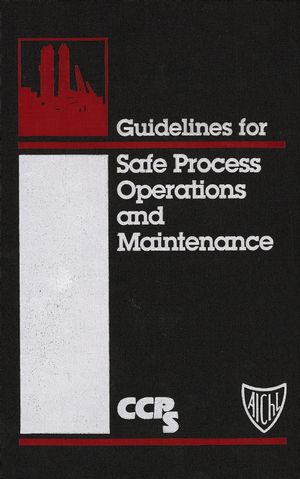Guidelines for Safe Process Operations and MaintenanceISBN: 978-0-8169-0627-7
Hardcover
352 pages
March 1995
 This is a Print-on-Demand title. It will be printed specifically to fill your order. Please allow an additional 10-15 days delivery time. The book is not returnable.
|
||||||
Acknowledgments.
List of Tables.
List of Figures.
Glossary.
1. INTRODUCTION.
1.1 Process Safety Management Activities of the Center for Chemical Process Safety (CCPS).
1.2 Process Safety Activities of Governmental Agencies and Trade Organizations.
1.3 Target Audience and Objective of This Document.
1.4 Use of This Document.
1.5 References.
2. ROLE OF OPERATIONS AND MAINTENANCE IN PROCESS SAFETY MANAGEMENT.
2.1 Accountability.
2.2 Process Knowledge and Documentation.
2.3 Capital Project Review and Design Procedures.
2.4 Process Risk Management.
2.5 Process and Equipment Integrity.
2.6 Human Factors.
2.7 Training and Performance.
2.8 Incident Investigation.
2.9 Standards, Codes, and Regulations.
2.10 Audits and Corrective Action.
2.11 Enhancement of Process Safety Knowledge.
2.12 Management of Change.
2.12.1 Importance of Changes.
2.12.2 Examples of Lessons To Be Learned from the Failure to Manage Change.
2.12.3 What Constitute Change?
2.12.4 Process Change Authorization.
2.13 Summary.
2.14 References.
3. PLANT DESIGN.
3.1 Operations and Maintenance Departments’ Roles.
3.2 Documentation.
3.3 Process Hazard Reviews.
3.4 Designing for Inherent Process Safety.
3.4.1 Process Fluids.
3.4.2 Inventory Minimization.
3.4.3 Operating and Storage Conditions.
3.5 Controlling of Hazards to Reduce Risks.
3.6 Plant Layout.
3.6.1 Site Planning.
3.6.2 Process Area Layout.
3.7 Plant Standards and Practices.
3.8 Human Factors in Plant Design.
3.9 Maintenance Considerations.
3.10 Management of Change.
3.11 References.
4. PLANT CONSTRUCTION.
4.1 Roles of the Operations and Maintenance Department.
4.1.1 Communication and Coordination with Project Team.
4.1.2 Control of Specific Construction-Related Activities.
4.1.3 Inspection of Equipment Installation.
4.2 Materials of Construction.
4.3 Custom Equipment Fabrication and Inspection.
4.4 Field Installation.
4.4.1 Piping Installation.
4.4.2 Pressure-Relief/Vent Collection.
4.4.3 Other Safety Systems.
4.5 Equipment Recordkeeping.
4.6 Summary.
4.7 References.
5. PRE-STARTUP AND COMMISSIONING.
5.1 Organization and Roles.
5.1.1 Startup Team.
5.1.2 Role of Operations and Maintenance Departments.
5.2 Planning.
5.3 Preparation for Startup.
5.3.1 Staffing Operations and Maintenance Departments.
5.3.2 Training.
5.3.3 Maintenance Activities during Pre-startup.
5.3.4 Development of Operating Procedures.
5.4 Pre-startup Safety Review.
5.5 Commissioning.
5.5.1 Commissioning Utilities.
5.5.2 Commissioning Equipment.
5.5.3 Instruments, Computer, and Control.
5.6 Final Preparations for Startup.
5.7 References.
6. STARTUP.
6.1 Roles and Responsibilities.
6.2 Initial Startup.
6.2.1 Final Preparation.
6.2.2 Introduction of Process Chemicals and Materials.
6.2.3 Process and Process Equipment Monitoring.
6.2.4 Baseline Data.
6.2.5 Updating Startup Procedures.
6.3 Restart.
6.4 Startup after Turnaround.
6.5 Startup after Extended Outage.
6.6 Resources.
6.7 Summary.
6.8 References.
7. OPERATION.
7.1 Roles and Responsibilities.
7.2 Routine Operations.
7.2.1 Operating within Process and Equipment Limits.
7.2.2 Written Procedures.
7.2.3 Communication.
7.2.4 Communication During Shift Changes.
7.2.5 Special Safety Considerations of Batch Processes.
7.2.6 Process Control Software.
7.3 Nonroutine Operations.
7.3.1 Abnormal Operations.
7.3.2 Standby Operations.
7.4 Emergency Operations.
7.5 Management of Change.
7.6 Safety Protective Systems.
7.6.1 Safety Shutdown Systems.
7.6.2 Pressure Relief Equipment.
7.7 Operator Training.
7.7.1 Refresher Training.
7.7.2 Playing “What-If” Games.
7.8 Incident Investigation.
7.8.1 Recognizing and Reporting Incidents.
7.8.2 The Investigation.
7.8.3 Investigation Results and Followup.
7.9 Human Factors.
7.9.1 Human-Process Interfaces.
7.9.2 Behavioral Issues.
7.9.3 Spontaneous Response.
7.10 Audits, Inspections, Compliance Reviews.
7.11 Summary.
7.12 References.
8. MAINTENANCE.
8.1 Roles and Responsibilities.
8.2 Routine Maintenance.
8.2.1 Preventive Maintenance.
8.2.2 Predictive Maintenance.
8.2.3 Communication between the Maintenance and Operations Departments.
8.2.4 Communication at Shift Change.
8.3 Nonroutine Maintenance.
8.3.1 Breakdown Maintenance.
8.3.2 Troubleshooting Maintenance.
8.4 Management of Change.
8.5 Aging Equipment.
8.5.1 Corrosion, Erosion, and Fatigue.
8.5.2 Wear, Intermittent Operation, and Fouling.
8.6 Critical Instrumentation and Safety Interlocks.
8.6.1 Proof Testing.
8.6.2 Critical Instrumentation and Interlock Classification.
8.7 Maintenance Training.
8.7.1 Upgrade and Refresher Training.
8.7.2 Loss of Plant-Specific Maintenance Knowledge.
8.8 Work Permits.
8.9 Maintenance Management Information Systems.
8.9.1 Work Order Tracking.
8.9.2 Process Equipment Files.
8.9.3 Process and Equipment Drawings.
8.10 Quality Control.
8.10.1 Replacement Parts.
8.10.2 Inspection.
8.10.3 Certified Equipment.
8.10.4 Continuous Improvement.
8.11 Contractor Safety.
8.12 Incident Investigation.
8.13 Summary.
8.14 References.
Addition References.
9. SHUTDOWN.
9.1 Normal Shutdown.
9.1.1 Pre-shutdown Planning.
9.1.2 Shutdown Sequence Steps.
9.1.3 Testing Safety Protective Systems.
9.1.4 Shutdown Period Maintenance Activities.
9.1.5 Unit Restart after Maintenance.
9.1.6 Formal Review of Shutdown.
9.2 Extended or Mothball Shutdown.
9.3 Sudden or Emergency Shutdown.
9.3.1 Preplanning for Student Shutdown.
9.3.2 Shutdown Sequences.
9.3.3 Safety Interlock Failures.
9.3.4 Investigation of Sudden Shutdown.
9.4 Emergency Response.
9.5 Summary.
9.6 References.
10. DECOMMISSIONING AND DEMOLITION.
10.1 Decommissioning/Demolition Plan.
10.2 Operation and Maintenance Roles.
10.3 Decommissioning Procedures.
10.4 Maintenance of Decommissioned Status.
10.5 Demolition Concerns.
10.6 Summary.
10.7 References.
Appendix A. Summary of the Process Safety Management Rule Promulgated by the Occupational Safety and Health Administration, United States Department of Labor.
Appendix B. Example Management Guidelines for the Safe Dismantling and Demoliton of Process Plants.
Appendix C. Examples of Site-Specific Demolition Checklist/Questionnaire.
Index.



